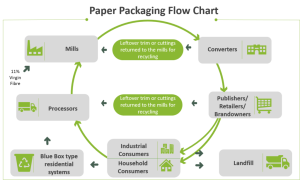Don’t get me wrong. I fully support the use of more post-consumer material in packaging and products. Just not some of the BS that goes with it. And this is important because governments are stipulating post-consumer content without knowing all the facts. Here are some of the false claims being made:
False Claim # 1: That post-consumer is ‘environmentally better’ than pre-consumer content
Setting aside the big question of what ‘environmentally better’ actually means, I am not aware of any scientific evidence that one is ‘better’ than the other. In fact, they are really the same material, just coming from different places along the feedstock supply chain.
In the paper industry, for example, there is no difference in the way that pre-consumer and post-consumer paper or board is originally manufactured in a mill. It is exactly the same material with the same environmental production inputs. The only difference is that they come back to the recycling mill from a different place (one from a converting operation and the other from the back of factories, supermarkets, offices or homes). In fact, it could be argued that pre-consumer has a lower environmental impact overall because it travels a shorter recycling loop back to the mill.
False Claim # 2: That post-consumer is ‘more circular’ than pre-consumer
Not true. Isn’t the circular economy all about minimising waste? So, what could be more circular than minimising waste at the converting stage? Pre-consumer material is like the off-cuts left after you cut a sewing pattern from cloth. Since you’ve already paid for the cloth, you make sure your design makes maximum use of the cloth you have. And what you have left over you send back (in the paper industry’s case) to a mill to be incorporated into another recycled content product. Nothing is wasted. Sounds pretty circular to me.

False Claim # 3: That post-consumer is ‘better’ because it replaces virgin material
Hogwash. Both pre-consumer and post-consumer replace virgin material. Both were made in a mill (once) and both are now recycled again (potentially many times).
And now for the unintended consequences of pushing 100% post-consumer content. If a company or a government specifies only 100% post-consumer content, what’s going to happen? Some suppliers may be able to produce only 100% post-consumer content, but who’s going to verify it? Those off-cuts mentioned earlier will still be coming to a paper recycling mill from other customers. What’s the mill or converter supposed to do with them now? Dump them? That would not exactly meet the ideals of a circular economy now, would it? And what about a mill tempted to add just a little bit of pre-consumer to the mix? Who will know, except the mill?
There are also physical limitations of the material to bear in mind. Wood fibres, for example, can only be recycled between four and nine times before they become too short and thin to be used again. So, if all paper was required to be 100% recycled content, it wouldn’t be too long before you couldn’t make paper at all. An infusion of virgin fibre is always required somewhere in the system to keep the whole recycling loop going.
So, what’s the solution? By all means specify a recycled content number, but give the industry the flexibility to meet the target by not specifying how much should be pre-consumer and how much post-consumer. There is far less pre-consumer material out there (because companies are economically motivated to reduce their production costs). And once it’s gone, it’s gone. If companies need more recycled content to make their products or packaging, they’ll be forced to get it from post-consumer sources. That’s how the market works. That’s why the corrugated box industry started targeting residential sources of used paper decades ago. It couldn’t get enough from industrial sources.

paper packaging process is very usefull for boxes they depends on five things mills convertors processors publishers industrial consumers